4 ways to support employees and the organisation as a new CEO comes in
You’ve just heard the news: there’s going to be a new CEO. Or maybe you’re moving up to a position of leadership yourself. Either way, a change in leadership often leads to restructures and turbulent times. But it also often means opportunities, fresh ideas and new energy.
This is a crucial moment for HR departments, and the amount of change to implement as new leadership settles in can be overwhelming. Some employees may experience high levels of stress and anxiety, and most people are likely to have questions or concerns about the future. So, what can HR do to smooth the transition?
Whilst it is HR’s role to help onboard new leaders as well as look after employees throughout the change process, this can be a tough challenge. After all, you could be in the same boat as others, concerned about what this will mean for your own team, or your own career. You may also be privy to some information you are unable to share just yet, be it positive announcements or difficult ones.
How can you keep employees feeling safe whilst you put everything in motion? At Let’s Talk Talent (LTT), we have a few tips on how to manage the fallout that inevitably comes with new leadership.
The role of HR in managing leadership change
Big announcements, such as a new CEO or member of the C-suite, can be unsettling and strong emotions will undoubtedly be at play. Some employees may start to wonder why the previous leader has left and question whether the same thing could happen to them, whilst others will re-evaluate whether their values are aligned with the new direction.
Some companies have even seen a management turnover of up to 26% following the arrival of a new external CEO; a rate four times higher than the turnover seen in companies where the CEO did not change. How can HR help employees embrace the new normal when the new normal could mean so many different things?
Whether your organisation is taking a different strategic direction and exploring new markets, or implementing an internal restructure and reassigning staff, your focus should always remain the same: looking after employees’ wellbeing. For HR teams, this involves disseminating key information quickly and often, proactively listening to people, representing staff at the leadership table, and ensuring they have the support they need to get through the next steps.
However, at LTT, we know this can be a difficult job to do under pressure. You may be overwhelmed by the amount of work to do and the new initiatives to implement, or you may be going through the same uncertainty as the rest of your organisation’s talent pool.
Fortunately, even when your own energy reserves are tapped out, there are tools available to help you. Here’s how to stay the course and look after your people’s wellbeing during a change in leadership.
4 ways for HR to manage leadership change
1. Focus on your people
Change is hard; and, no matter its scale, some employees will need some support. Review your company’s current offering and evaluate whether it is sufficient. Could you, for example, provide staff that will be made redundant with placement services? Do you have an employee referral programme (ERP) to make it easier for them to find a new position? Could you give access to an employee assistance programme (EAP) that provides counselling?
A new strategic direction or internal restructure could also mean a change in assignment for some staff, and training or up-skilling could be required. Identify employees’ needs and find the right resources and initiatives to facilitate next steps.
Lastly, clear communication is one of the best ways to keep employees feeling safe. Make sure you communicate often, and that messaging is consistent, inclusive, and crafted for each of the key groups in your organisation.
2. Rely on established processes
When everything seems to be in constant motion, established procedures can be a solid anchor to help stop you from feeling overwhelmed. Use them to look at the workload objectively. After all, you’ve probably dealt with change before, and implementing change that results from the arrival of a new leader is no different.
Break down new initiatives into smaller workstreams and rely on proven processes to plan, implement, and deliver each of those streams. Methodically plan everything, from new hires to staff reshuffles, from reviewing succession plans to setting up new career paths for your people.
And what if you are the one moving up to a leadership role? There isn’t a step-by-step list of instructions for this scenario. “My first tip would be to take time to observe and learn before making any big decisions. Give yourself time to land,” says Jo Taylor, MD at LTT.
3. Use a change model to implement leadership change
Sticking to a proven method to smooth out the transition brought about by a new leader will ensure nothing falls by the wayside, and that your people’s wellbeing remains at the core of everything you do.
And, when it comes to change management models, the team at Let’s Talk Talent likes to rely on the BRIGHT methodology:
- Get buy-in: articulate the compelling reason for change.
- Resources and plans: think through the change to effective execution, from contracts to resources. Ensure you have everything you need to make it happen (right people, right skills).
- Inspire and lead with a vision: paint a clear picture of what the future looks and feels like for all those involved.
- Galvanise the troops and get people going: this step is about engaging your team and getting the best out of all your stakeholders.
- Help everyone succeed: think about how to lead the business (and the team) through the ups and downs of change.
- Track everything to make change stick: evaluate, learn from, and celebrate the change.
4. Seek the right support
Anchoring yourself and your team by focusing on established processes and solid methodology can indeed facilitate change and give you a clear direction. But what do you do when new situations arise that you either haven’t planned for or faced before? What if there is no rulebook for what you’re going through? Here, asking for help is the only way to go.
Consider some coaching sessions (have a look at LTT’s Coach on Demand service for ad hoc sessions with an external coach), confer with a mentor, or appeal to your network for advice. Don’t forget, you are not alone.
Managing leadership change with empathy
It’s inevitable: new leadership means change. And prioritising the needs of others can be a difficult thing to do when your energy reserves are at their lowest.
Compartmentalising to focus on processes and getting sh*t done is key, but empathy does need to be at the core of everything you do.
To reach that goal, you may need to be realistic about the support you are able to offer at any given time. Check in with yourself often, and reach out for help whenever you need it.
Lastly, know when you’ve reached your limit and need to walk away. Don’t forget that taking care of yourself is the only way to ensure the rest of the organisation’s talent pool is taken care of too.
If you’re faced with a difficult transition or a sudden change in leadership and want to know how to best support your people, don’t hesitate to book a chat with us. We’d love to help you plan the next steps. In the meantime, download our free HR strategy whitepaper.

